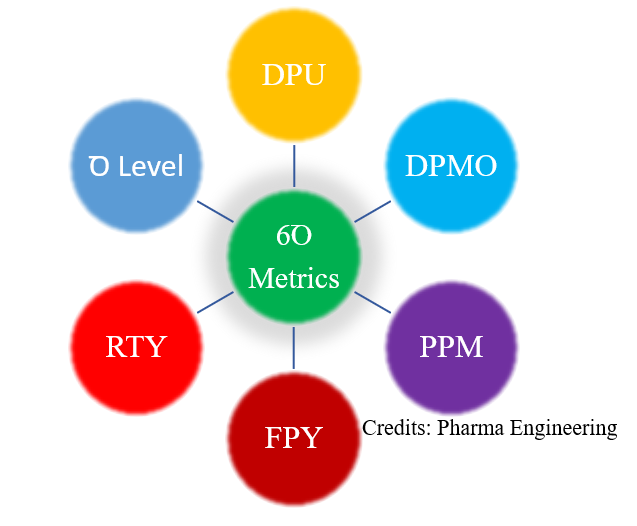Today i'm going to share a topics which is related to SixSigma.
What i found from most of the enrgineers is that they dont have any idea about SixSigma, but in reality it is one of the criteria which determines one's potential about problem solving.
I'll would like to share few things about SixSigma from now so that it could brush up my knowlegde and also add something to the readers.
Today i've selected to post about the metrics of SixSigma i.e., the medium with which we are going to showcase our improvements which are done during a project.
The basics metrics that we use are DPO, DPU, DPMO, PPM, FPY, RTY & Sigma Level.
Lets see about these metrics one by one.
But before going into these topics, we need to understand the difference between defects and defectives.
Simply, Defect means not meeting a specific requirement or failing to achieve a specific customer CTQ (Critical To Quality).
Defectives means a product or service with more than one defect and we call it as a rejected piece,
Often the product with defect can be accepted by customer but not the defectives.
Now, lets get into the calculation part with some examples.
i. DPU refers to Defects Per Unit
It helps to quantify individual defects on a unit or number of defects per manufactured unit.
DPU = Total defects / Total units produced
For an example, if we have manufactured 300 batches and out of 300 batches, total of 30 defects were identified, then the DPU = 30 / 300 = 0.1.
ii. DPMO refers to Defects Per Million Opportunities
Name itself indicates that if you consider one million opportunities, then the defects identified in that million opportunities refers to DPMO.
For an example, you have manufactured 300 batches and you have tested the sample for complete analysis and again lets consider that the complete analysis consists of 10 randome tests, which means there are 10 opportunities in a single batch to fail.
Hence for total of 300 batches, the number of opportunities to fail is 300 x 10 = 3000.
And lets say the identified defects are 30, so the DPO = 30 / 3000 = 0.01.
DPMO = DPO x 1000000 = 0.01 x 1000000 = 10000.
iii. PPM refers to Parts Per Million
To calculate the PPM we'll use defectives i.e., the rejected pieces
PPM is nothing but to count the number of defective parts per million produced.
For an example, lets say we have manufactured 300 batches and the rejected batches are 30.
So the percentage is going to be 30/300 = 0.1 and the PPM is going to be 0.1 x 1000000 = 100000.
iv. FPY refers to First Pass Yield
First Pass Yield helps us to identify the batches which are passed without any defects for the first time (i.e., without considering the reprocesses).
Lets say for an example, batches executed were 300 and the failed batches were 30,
So the FPY = (300 - 30) / 300 = 270 / 300 = 0.9 ~90%.
v. RTY refers to Rolled Throughput Yield
So, whenever we have multiple stages of product manufacturing, then we can use the Rolled Throughput Yield. RTY is a product of FPY for multiple stages.
Lets say, we have a product which is being executed in three stages and the FPY's of these three stages are 0.9, 0.85 & 0.95. So, the RTY = FPY1 x FPY2 x FPY3 = 0.9 x 0.85 x 0.95 = 0.72675 ~0.73
vi. Finally the Sigma level, this is the most commonly used metric.
Sigma level indicates available standard deviation between data points of a data set that we have collected. USing the sigma level we can calculate the DPMO and vice versa.
Below is the formula for calculating the sigma level.
Sigma level = normsinv(1-(D/O)) + 1.5, 1.5 refers to the sigma shift
** Use the formula in excel
Lets say, the total defects are 30 and opportunities are 3000, so
Sigma level = normsinv(1-(30/3000)) + 1.5 = 3.826 ~3.83
This is how we need to estimate the metrics of six sigma while executing any improvement projects.
Below is the simple related between sigma level and the DPMO, which is estimated based on the above formulas:
Super Survey Maker
About The Author
| DPMO | Sigma-level | Yield, % |
|---|---|---|
| 3.4 | 6 | 99.99966% |
| 230 | 5 | 99.977% |
| 6210 | 4 | 99.379% |
| 66800 | 3 | 93.32% |
| 308000 | 2 | 69.2% |
| 690000 | 1 | 31% |
For any queries in the above content, please feel free to contact me at pharmacalc823@gmail.com
Comments are most appreciated.... !!!
You can follow our youtube channel for more updates, Stay subscribed





 Hi! I am Ajay Kumar Kalva, owner of this site, a tech geek by passion, and a chemical process engineer by profession, i'm interested in writing articles regarding technology, hacking and pharma technology.
Hi! I am Ajay Kumar Kalva, owner of this site, a tech geek by passion, and a chemical process engineer by profession, i'm interested in writing articles regarding technology, hacking and pharma technology. 
No comments:
Post a Comment